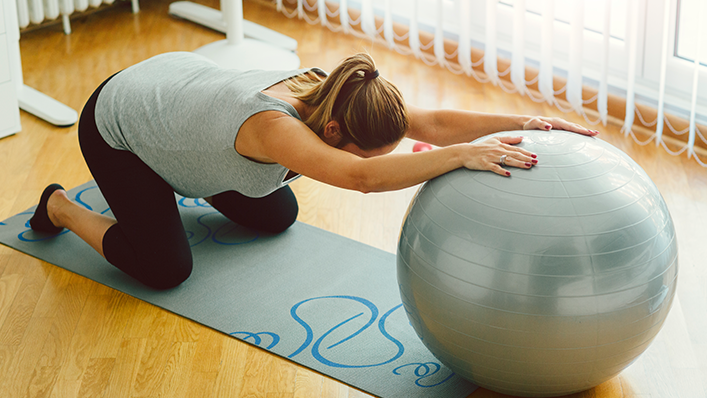Are you wondering when the best time is to start using an exercise ball during your pregnancy? You might have heard about its benefits but aren’t sure if it’s safe or effective for you right now.
Using an exercise ball can help ease discomfort, improve your posture, and even prepare your body for labor. But timing is key. You’ll discover exactly when to begin using an exercise ball, how it can support your changing body, and simple tips to make the most of it safely.
Keep reading to find out how this simple tool could make a big difference in your pregnancy journey.
Benefits Of Exercise Balls During Pregnancy
Exercise balls offer many benefits during pregnancy. They support a healthy body and mind. Using an exercise ball can make daily activities easier. It also helps prepare the body for labor. Many pregnant women find them comfortable and safe.
Exercise balls improve strength, balance, and posture. They reduce discomfort and pain. These benefits make pregnancy more enjoyable and active.
Improving Posture And Balance
Sitting on an exercise ball encourages good posture. It helps keep your back straight and shoulders relaxed. Good posture reduces pressure on your spine. It also improves your balance as your body adjusts. This helps prevent falls and injuries.
Relieving Back Pain
Back pain is common during pregnancy. Exercise balls ease this pain by supporting the lower back. Gentle bouncing or rolling on the ball loosens tight muscles. It also helps reduce stiffness. Many women feel less pain after short sessions.
Enhancing Pelvic Floor Strength
Strong pelvic floor muscles support the uterus and bladder. Using an exercise ball helps strengthen these muscles gently. Sitting and doing simple moves on the ball activates the pelvic area. This can make labor easier and recovery faster.

Credit: www.wikihow.com
Safe Timing To Begin Exercise Ball Use
Using an exercise ball during pregnancy can help with comfort and strength. Knowing the safe time to start is important for both mother and baby. Different stages of pregnancy have different needs and risks. Choosing the right time helps avoid injury and supports a healthy pregnancy.
First Trimester Considerations
During the first trimester, the body adjusts to pregnancy changes. Some women feel tired or nauseous. Gentle use of the exercise ball is okay for light stretching. Avoid heavy or intense exercises. Always listen to your body and stop if you feel pain.
Second Trimester Advantages
The second trimester is often the best time to begin regular exercise ball use. Energy levels usually improve. The belly grows but balance is still good. Sitting and gentle bouncing on the ball can relieve back pain. It also helps improve posture and strengthen core muscles.
Third Trimester Precautions
In the third trimester, the baby grows larger. Balance may become harder to maintain. Use the ball near a wall or a sturdy surface. Avoid quick or jerky movements. Focus on slow, controlled exercises. Always check with your healthcare provider before starting new activities.
Choosing The Right Exercise Ball
Choosing the right exercise ball during pregnancy is very important. It helps support your body and keeps you comfortable. The right ball improves your balance and can ease pregnancy pains. Picking the correct size and material makes a big difference. You also need to check how much it is inflated. Safety features protect you and your baby while you exercise.
Size And Material Matters
Pick a ball that fits your height. If you sit on it, your knees should be level with your hips. Too big or too small can cause discomfort or poor posture. Choose a ball made from thick, burst-resistant material. This helps prevent accidents if the ball pops. Look for a soft surface that feels good on your skin.
Inflation Tips For Comfort
Inflate the ball until it is firm but still soft. A too-hard ball can strain your back. A too-soft ball will not support your weight well. Check the ball’s size after inflation. It should match your height guidelines. Keep some air out if you need a softer feel. Test it by sitting and bouncing gently.
Safety Features To Look For
Choose a ball with anti-burst technology. This prevents sudden popping during use. Look for a non-slip surface to avoid falls. Some balls come with a textured finish for grip. Check for a weight limit that matches your needs. Always use the ball on a flat, stable surface for safety.

Credit: www.nhs.uk
Recommended Exercises With Exercise Ball
Using an exercise ball during pregnancy offers many benefits. It helps improve flexibility, balance, and strength. The ball supports your body and reduces strain. You can do several safe exercises with it. These exercises prepare your body for childbirth and ease discomfort.
Gentle Stretching Moves
Sitting on the ball, rock your hips slowly side to side. This move loosens your lower back and pelvis. Try gentle circles with your hips while seated. These stretches reduce tension and improve blood flow. Always move smoothly and stop if you feel pain.
Core Strengthening Exercises
Use the ball to support your lower back during core exercises. Sit on the ball and tighten your belly muscles. Hold this position for a few seconds and relax. Try gentle pelvic tilts while resting your back on the ball. These exercises build strength without stress.
Pelvic Floor Workouts
Sit upright on the ball and focus on tightening your pelvic muscles. Hold the squeeze for a few seconds, then release. Repeat this exercise to improve muscle control. Pelvic floor workouts help with labor and recovery. The ball adds gentle support during these moves.
Precautions And When To Avoid
Using an exercise ball during pregnancy can help improve comfort and strength. Still, it is important to take certain precautions to stay safe. Some situations require avoiding the ball altogether. Knowing when to stop and how to adjust exercises keeps both mother and baby safe.
Signs To Stop Using The Ball
Stop using the exercise ball immediately if you feel pain. Dizziness or nausea are warning signs. Bleeding or unusual discharge means stop at once. Any sudden swelling or sharp cramps need attention. These signs show your body needs rest and care.
Consulting Your Healthcare Provider
Talk to your doctor before starting ball exercises. Share your pregnancy history and any health issues. Your provider can suggest safe moves and limits. Follow their advice to avoid risks. Regular check-ups help adjust your exercise plan.
Adapting Exercises To Your Condition
Modify exercises as your pregnancy progresses. Use slow, gentle movements to reduce strain. Support your back and avoid overbalancing. Choose a ball size that fits your height. Stop or change moves if they feel uncomfortable.

Credit: www.thevbaclink.com
Incorporating Exercise Ball Into Daily Routine
Adding an exercise ball to your daily routine helps keep your body active. It supports your back and improves posture during pregnancy. Using it regularly can ease pregnancy discomfort and prepare you for labor. Small, steady efforts count the most. Start with simple moves and listen to your body.
Short Sessions For Busy Moms
Even 5 to 10 minutes can make a difference. Use the ball while watching TV or taking breaks. Short sessions fit easily into a busy day. Focus on gentle bouncing or pelvic tilts. These moves help reduce back pain and improve circulation.
Combining With Other Prenatal Activities
Exercise balls pair well with prenatal yoga or stretching. Use the ball to support balance during standing poses. It adds variety and helps target different muscles. Switching between activities keeps exercise fun and less tiring. Always move slowly and avoid sudden motions.
Tracking Progress And Comfort Levels
Note how your body feels after each session. Keep a journal to track comfort and any pain. Adjust your routine based on this feedback. Stop if you feel dizzy or uncomfortable. Comfort is key for safe exercise during pregnancy.
Frequently Asked Questions
When Is The Best Time To Start Using An Exercise Ball In Pregnancy?
You can start using an exercise ball after the first trimester. This is when your body adjusts to pregnancy changes. Always consult your healthcare provider before beginning any exercise routine with the ball.
How Does An Exercise Ball Benefit Pregnant Women?
An exercise ball improves posture, strengthens core muscles, and relieves back pain. It also helps prepare the body for labor by opening the pelvis and enhancing flexibility.
Is It Safe To Use An Exercise Ball During Early Pregnancy?
Using an exercise ball in early pregnancy is generally safe if you have no complications. Always avoid strenuous movements and seek medical advice before starting any new exercise.
Can Exercise Balls Help With Labor Preparation?
Yes, exercise balls help open the pelvis and promote optimal baby positioning. Gentle bouncing and pelvic tilts on the ball may ease labor and reduce discomfort.
Conclusion
Starting to use an exercise ball during pregnancy helps improve comfort and strength. Most women find it safe after the first trimester, but checking with a doctor is best. Gentle movements on the ball can ease back pain and prepare the body for childbirth.
Use the ball regularly but listen to your body’s signals. Remember, every pregnancy is different. The right time depends on how you feel and your doctor’s advice. An exercise ball can support a healthy pregnancy when used carefully and correctly.
